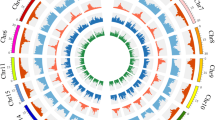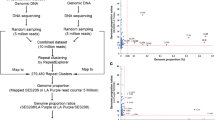Abstract
A DNA sequence between two legumin genes in Pisum is a member of the copia-like class of retrotransposons and represents one member of a polymorphic and heterogeneous dispersed repeated sequence family in Pisum. This sequence can be exploited in genetic studies either by RFLP analysis where several markers can be scored together, or the segregation of individual elements can be followed after PCR amplification of specific members.
Similar content being viewed by others
References
Benton WD, Davis RW: Screening λgt recombinant clones by hybridization to single plaques in situ. Science 196: 180–182 (1977).
Bernatzky R, Tanksley SD: Genetics of actin-related sequences in tomato. Theor Appl Genet 72: 314–321 (1986).
Bhattacharya MK, Smith AM, Ellis THN, Hedley C, Martin C: The wrinkled-seed character of pea described by Mendel is caused by a transposon-like insertion in a gene encoding starch branching enzyme. Cell 60: 115–122 (1990).
Birnboim HC, Doly J: A rapid alkaline extraction procedure for screening recombinant plasmid DNA. Nucl Acids Res 7: 1513–1523 (1979).
Blixt S: The Pea. In: King RC (ed) Handbook of Genetics, vol 2, pp 181–221. Plenum Press, New York (1974).
Clewell DB, Helinski DR: Properties of a supercoiled deoxyribonucleic acid-protein relaxation complex and strand specificity of the relaxation event. Biochemistry 9: 4428–4440 (1970).
Conaday J, Guillemaut P, Weil J-H: The nucleotide sequences of the initiator transfer RNAs from bean cytoplasm and chloroplasts. Nucl Acids Res 8: 999–1008 (1980).
Day A, Schirmer-Rahire M, Kuchka MR, Mayfield SP, Rochaix J-D: A transposon with an unusual arrangement of long terminal repeats in the green alga Chlamydomonas reinhardtii. EMBO J 7: 1917–1927 (1988).
Denhardt DT: A membrane-filter technique for the detection of complementary DNA. Biochem Biophys Res Comm 23: 641–646 (1966).
Dente L, Cesareni G, Cotrese R: pEMBL: a new family of single stranded plasmids. Nucl Acids Res 11: 1645–1655 (1983).
Domoney C, Ellis THN, Davies DR: Organization and mapping of legumin genes in Pisum. Mol Gen Genet 202: 280–285 (1986).
Dunsmuir P, Brorein WJJr, Simon MA, Rubin GM: Insertion of the Drosophila transposable element copia generates a 5 base pair duplication. Cell 21: 575–579 (1980).
Ellis THN, Cleary W: Trisomy: a useful adjunct to RFLP mapping. Chromosoma 96: 91–94 (1988).
Ellis THN, Davies DR, Castleton JA, Bedford ID: The organization and genetics of rDNA length variants in peas. Chromosoma 91: 74–81 (1984).
Ellis THN, Domoney C, Castleton J, Cleary W, Davies DR: Vicilin genes in Pisum. Mol Gen Genet 205: 164–169 (1986).
Ellis THN, Lee D, Thomas CM, Cleary WG, Newman M-A, Burcham KWG: 5S rRNA genes in Pisum: Sequence, long range and chromosomal organization. Mol Gen Genet 214: 333–342 (1988).
Farabaugh PJ, Fink GR: Insertion of the eucaryotic transposable element Tyl creates a 5 base pair duplication. Nature 286: 352–356 (1980).
Feinberg AP, Vogelstein B: A technique for radiolabeling DNA restriction endonuclease fragments to high specific activity. Anal Biochem 132: 6–13 (1984).
Gatehouse JA, Brown D, Gilroy J, Levasseur M, Castleton J, Ellis THN: Two genes encoding ‘minor’ legumin polypeptides in pea (Pisum sativum L.). Biochem J 250: 15–24 (1987).
Gebhardt C, Ritter E, Debener T, Schachtschabel U, Walkemeier B, Uhrig H, Salamini F: RFLP analysis and linkage mapping in Solanum tuberosum. Theor Appl Genet 78: 65–75 (1989).
Grunstein M, Hogness D: Colony hybridization: a method for the isolation of cloned DNAs that contain a specific gene. Proc Natl Acad Sci USA 72: 3961–3965 (1975).
Harker C, Ellis THN, Coen ES: Identification and genetic regulation of the chalcone synthase multugene family in Pisum sativum. Plant Cell, in press.
Henikoff S: Unidirectional digestion with exo-nuclease III creates targeted breakpoints for DNA sequencing. Gene 28: 351–359 (1984).
Higuchi R, Krummel B, Saiki RK: A general method of in vitro preparation and specific mutagenesis of DNA fragments: study of protein and DNA interactions. Nucl Acids Res 16: 7351–7367 (1988).
Ish-Horowicz D, Burke JF: Rapid and efficient cosmid cloning. Nucl Acids Res 9: 2989–2998 (1981).
Jeffreys AJ, Wilson V, Thein SL: Hypervariable ‘minisatellite’ regions in human DNA. Nature 314: 67–73 (1985).
Jeffreys AJ, Wilson V, Thein SL: Individual-specific ‘fingerprints’ of human DNA. Nature 316: 76–79 (1985).
Jeffreys AJ, Wilson V, Neumann R, Keyte J: Amplification of human minisatellites by the polymerase chain reaction: towards DNA fingerprinting of single cells. Nucl Acids Res 16: 10953–10971 (1988).
Johns MA, Babcock MS, Fuerstenberg SM, Fuerstenberg SI, Freeling M, Simpson RB: An unusually compact retrotransposon in maize. Plant Mol Biol 12: 633–642 (1989).
Krawczak M, Reiss J, Schmidtke J, Rösler U: Polymerase chain reaction: replication errors and reliability of gene diagnosis. Nucl Acids Res 17: 2197–2201 (1989).
Maniatis T, Jeffrey A, Kleid DG: Nucleotide sequence of the rightward operator of phage λ. Proc Natl Acad Sci USA 72: 1184–1188 (1975).
Murray NE, Brammar WJ, Murray K: Lambdoid phages that simplify the recovery of in vitro recombinants. Mol Gen Genet 150: 53–61 (1977).
Murray WF, Thompson MG: Sequence organisation in pea and mung bean DNA and a model for genome evolution. In: Davies DR, Hopwood DA (eds) The Plant Genome, pp 31–45. The John Innes Charity (1979).
Nevers P, Shepherd NS, Saedler H: Plant transposable elements. Adv Bot Res 12: 103–203 (1986).
Norrander J, Kempe T, Messing J: Construction of improved M13 vectors using oligonucleotide-directed mutagenesis. Gene 26: 101–106 (1983).
Rhodes PR, Vodkin LO: Organization of the Tgm family of transposable elements in soybean. Genetics 120: 597–604 (1988).
Roeder GS, Fink GR: Transposable elements in yeast. In: Shapiro JA (ed) Mobile Genetic Elements, pp 299–328. Academic Press, New York (1983).
Sanger F, Nicklen S, Coulson AR: DNA sequencing with chain terminating inhibitors. Proc Natl Acad Sci USA 74: 5463–5467 (1977).
Shirsat AH: A transposon-like structure in the 5′ flanking sequence of a legumin gene from Pisum. Mol Gen Genet 212: 129–133 (1988).
Southern EM: Gel electrophoresis of the restriction fragments. Meth Enzymol 68: 152–176 (1979).
Temin HM: Structure, variation and synthesis of retrovirus long terminal repeat. Cell 27: 1–3 (1981).
Varmus HE: Retroviruses. In: Shapiro JA (ed) Mobile Genetic Elements, pp 411–503. Academic Press, New York (1983).
Yanisch-Perron C, Vieira J, Messing J: Improved M13 phage cloning vectors and host strains: nucleotide sequences of the M13mp18 and pUC19 vectors. Gene 33: 103–119 (1985).
Author information
Authors and Affiliations
Rights and permissions
About this article
Cite this article
Lee, D., Ellis, T.H.N., Turner, L. et al. A copia-like element in Pisum demonstrates the uses of dispersed repeated sequences in genetic analysis. Plant Mol Biol 15, 707–722 (1990). https://doi.org/10.1007/BF00016121
Received:
Accepted:
Issue Date:
DOI: https://doi.org/10.1007/BF00016121




